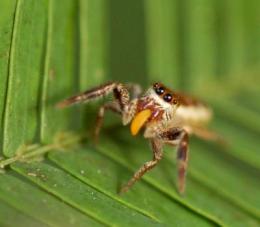First spider that dines mainly on vegetarian fare discovered
 Washington, October 13 : Scientists have discovered the first spider that dines primarily on vegetarian fare.
Washington, October 13 : Scientists have discovered the first spider that dines primarily on vegetarian fare.
There are approximately 40,000 species of spiders in the world, all of which have been thought to be strict predators that feed on insects or other animals.
Now, in a new research, scientists have found that Bagheera kiplingi, a small Central American jumping spider, has a uniquely different diet: it feeds predominantly on plant food.
Christopher Meehan of Villanova University and Eric Olson of Brandeis University led the research.
According to Meehan, "This is the first spider in the world known to deliberately ''hunt'' plant parts; it is also the first found to go after plants as a primary food source."
The spiders do occasionally prey on small invertebrates, but the researchers confirmed through both field observations and chemical analyses of the spiders'' tissue that these arachnids eat a primarily vegetarian diet.
"I''ve done the math several times, and even the most conservative estimates point to near-total vegetarianism," Meehan said.
The researchers have revealed the extraordinary ecology and behavior in Bagheera kiplingi, which lives throughout much of Central America and southern Mexico.
There, the spider inhabits several species of acacia shrubs involved in a co-evolutionary mutualism with certain ants.
The ants fiercely guard the plants against most would-be herbivores, while the acacias provide both housing for the ants via swollen, hollow spines and food in the form of nectar and specialized leaf tips known as Beltian bodies.
The Bagheera spiders are "cheaters" in the ant-acacia system, stealing and eating both nectar and-most remarkably-Beltian bodies without helping to defend the plant.
The spiders get the job done through active avoidance of patrolling acacia-ants, relying on excellent eyesight, agility, and cognitive skills.
Spiders in Costa Rica more frequently supplemented plant food with animal prey items, including ant larvae.
"What surprised us most about discovering this spider''s extraordinary ecology was to find it on the ant-acacias," according to study co-author Robert Curry.
"This well-known mutualism has been studied by tropical ecologists for nearly 50 years, yet the spider''s role was not noticed until Olson''s discovery in 2001," he added.
Bagheera lives and nests on the acacia plants at very high densities, with hints of males helping to care for eggs and young, another behavior that is virtually unknown among spiders.
This suggests that the transition to herbivory in Bagheera may have strongly influenced the species'' social evolution, a possibility that the researchers are continuing to study. (ANI)